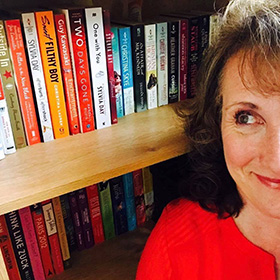I have a new book out this week called How to Revise and Re-Release Your Book and I wrote it because rebooting books is kind of a big deal right now – especially if your goal is to sell more books. There are lots of reasons revising and re-releasing your book is a good idea. Maybe you didn’t get it quite right when the book first launched, maybe it needs revision, or maybe the book is old and you want to breathe new life into it by re-releasing it. These are all great reasons to consider a reboot. And it’s certainly a great way to sell more books. Once you’ve made this decision, your next question might be whether or not you need a new book cover.
In almost every case, the answer to this is going to be a resounding yes.
But there are a few exceptions!
Surprisingly, or maybe not, getting authors to change a book cover can be a big deal. This seems counter-intuitive when they’re ready to pay thousands of dollars for my expertise in every other area of book marketing!
Still not sure? Here’s a list of the top things you’ll want to ask yourself about your book cover if you’re planning to re-release your book.
What’s Your Genre?
The biggest problem with covers is that they don’t often match the genre, meaning that book covers don’t have the “look” of the genre. Getting this right is very, very important. A good way to start is by stepping back and taking a hard look at how your cover compares with every other book in your genre or nonfiction category, particularly if they’re selling relatively well.
When was the last time you asked yourself: What does my audience expect from my book cover? Or, perhaps even better: What does my audience look for when they want to buy a book in my genre or category?
Is Your Cover Readable Enough to Sell More Books?
Have you looked at your Amazon book page recently? I ask this because if you’ve seen how cluttered these pages are with other stuff Amazon is trying to push, then you know that the last thing you want on that page is a book cover that isn’t 100% on point with your target buyer.
A book cover with scrolly fonts or too many elements jammed in, or that doesn’t have the right balance (the font isn’t big or bold enough), are also standouts as amateur jobs that make authors look disconnected and less than professional.
Look at NYT best-selling authors. You can read their titles from a mile away, and they’re usually supported by genre-appropriate imagery. They aren’t scared to scream for your attention. Also, most of these folks know that the importance of the book cover design goes beyond “screaming for your reader’s attention” but it’s also screaming for their attention on an already cluttered Amazon page. While you’re at it, check out Amazon’s little-known secret to help drive book sales!
What Does Your Imagery Speak To?
If you designed your first book cover with too many images, or the wrong images, you’re an ideal candidate for a reboot. Too many photographs (on your book cover) don’t give the buyer something to focus on. You’re making buyers work too hard. I see two common image mistakes over and over. One is choosing an image too detailed for online viewing. The other is featuring a big picture of you as the author when you’re not a household name or sales leader in your category. Check your ego at the door. If a buyer doesn’t recognize you, a big picture of yourself on the book cover is a lost opportunity.
Speaking of online viewing, this is something that continues to be ignored. Current statistics say approximately 70 percent of books are sold online. That means books are making first impressions based on very small images of the book cover.
Let that sink in.
A successful book cover will still be legible and impactful when it’s not much bigger than your thumbnail. Don’t make your decision solely based on a full-sized image file on your computer or the print copy on your desk. Your success depends on this. So if you want to sell more books, your book cover should be very readable from a distance when you re-release your book.
Is Your Book Cover Professionally Designed?
They say that the one main key to selling more books is to know your reader, and to write to your reader market. But this extends to a professional cover, too. Self-designed or hand-drawn covers are another no-no. And by this I mean hand-drawn that are actually just drawn on a page, without any kind of assistance from an artist or a professional designer. We’re seeing some “handwritten” covers but they’re all professionally developed. You should not have a hand-drawn book cover or a painting on the cover unless the book is about painting or drawing by hand. Even then, a professional cover designer can use your work in a way that’s also appealing as a product representation.
I once had an author who was a child therapist contact me wanting to use one of his patients’ paintings on the cover. The book was about dealing with difficult children. The problem with the painting was that it wasn’t clear what it was exactly. He had a connection with it, but the reality was, why would anyone else?
When you re-release your book, do yourself a favor and hire a professional book cover designer.
How Does Your Book Stack Up?
How does your book cover compare to top sellers? I will grant you that New York publishers don’t always get it right with some books they choose to publish, but their covers are (in most cases) spot on with the market.
They know you need to have a market match in order to capture a reader’s attention. If the book looks “off,” or doesn’t quite fit, you won’t stand out, but, more tragically, you won’t sell more books.
Covers that aren’t a genre match confuse the mind. Even before readers realize what they’re doing, the mind will click off the page. They jumped to the assumption that’s not the kind of book they’re looking for. And guess what? You’ve just lost a book sale!
Is Your Cover On Brand?
Conversely, if you’re considering whether a cover change is right for you, there might also be the question of brand.
Let’s use the For Dummies books as an example:
Everyone recognizes this brand just from the look of the books, right? What if they were to change this to, let’s say, a blue or a red cover. Not so recognizable anymore, is it?
Also keep in mind that if your book has a great cover and matches the genre it’s in, maybe all you need is a cover polish. Update the title by adding phrases like, “Newly enhanced edition,” or something similar. In some cases, you may want to simply add a banner or a ribbon at the corner of the book. If you got the rights to your book back or if you’re re-releasing a book, you could put a ribbon on it that reads: “Director’s Edition” or “Special Author Edition.”
These are just ideas; you don’t have to add anything to the cover. But in most cases, there will be something you can do to your cover to add pizzazz and give your book a better shot at increased sales.
Periodically Change Your Book Cover
This is a tip I learned by accident. We were working with an author who decided the original cover no longer suited the direction of her future books, so she redid it.
I advised her to leave the original on Amazon and just swap out the cover for the e-book to see what happened. As it turned out, refreshing your cover is a great thing and could help sell more books! Now, I don’t recommend doing it a lot, but a book cover relaunch will help you sell more books.
It’s rare that we don’t gain some new insight into a particular book’s reader market after it’s been out awhile, right? Or, like my example, the storyline takes a twist you weren’t originally planning on that changes the story’s “image.”
Why not take this golden information and use it to create a new cover that better attracts readers in your demographic and hopefully, sell more books?
What will a new cover cost you?
Well, anywhere from $150 to $500, and sometimes more.
Generally, nonfiction books fall into the pricier category. This is typically because the nuances for reaching their potential buyers need to be much more refined. So, the research to find successful competitive titles to pull marketing ideas from can be more labor-intensive.
But fiction can cost more, too—it really just depends. However, if you have a lot of books to redo (let’s say you’re re-releasing a series), then book covers can add up quickly. Search in your niche for a cover you like; ask the author who designed it. It’s a great place to start.
The final price mainly depends on your goals and how much branding work you require. If you feel strongly that your cover designer needs to read your book cover to cover, do not expect their price to be on the low end of my estimate. This is what these professionals do for a living, so respect their time and expertise and keep your expectations realistic. If you want to sell more books, it pays to invest.
The Bottom Line
If you have looked through this list of questions and nodded your head even once, then it’s time to carefully consider updating your book cover when you re-release your book. If your goal is to sell more books, and it should be, then it’s critical. And, if you could use some more information on revising and re-releasing a book, here’s a link to mine!





0 Comments
Trackbacks/Pingbacks